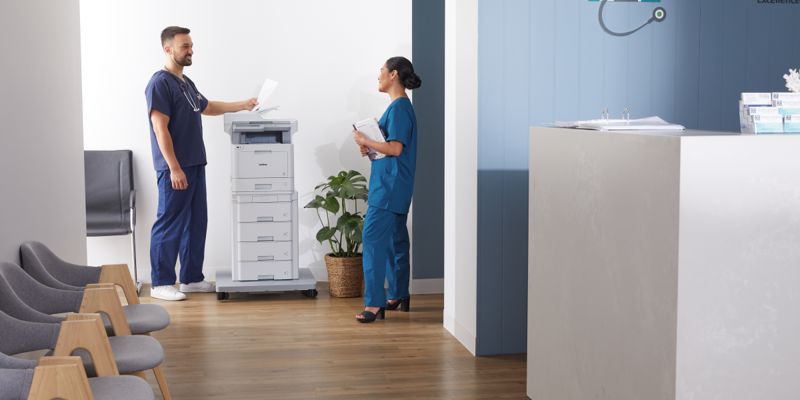Enabling digital transformation in the healthcare industry

Digital transformation is vital to the continued success of the Australian healthcare industry, particularly as it relates to record keeping and information management. It’s critical to provide the public with easy and secure access to health records and data. At the same time, there is urgency in offering tools that allow healthcare administrators to keep pace with workforce data in an increasingly digital environment.
Electronic health records (EHR) and electronic medical records (EMR) are digital ecosystems designed to centralise medication histories, patient charts, laboratory results and other personal information under one centralised environment. While EMR systems provide a healthcare facility with electronic access to their patient’s data, EHR takes things a step further and shares the information between providers.
This level of visibility is a tremendous asset for GPs who are referring out to surgeons or specialists. Rather than wait for patient charting information to be sent over, the requesting professional can simply access an authorised portal to view all of their updated information.
Cerner is one of the largest EHR providers, with a focus on hospitals and healthcare services. With a certification program to ensure that products connected to their systems work as expected, Cerner-certification has become an industry standard amongst the hundreds of available EHR software systems in Australia. Many large hospitals will stipulate Cerner validation for their incumbent devices, as it ensures hospital staff have EHR integrated tools available to them upon deployment.
This article will examine how Brother’s Cerner-certified range of multi-function centres (MFCs), scanners and mobile printing solutions equip healthcare professionals with the devices necessary to interact with digital architectures like the national My Health Record system.
Understanding the need for digital transformation
Traditionally, organisations manually captured data using pen and paper. These processes occasionally resulted in human error, lost documents and difficulty accessing information across multiple locations. Even worse, paper forms presented issues with data security and patient privacy. To counter these issues, clinicians began using EMR systems; digital solutions that streamline and protect information workflows in the healthcare industry.
For these reasons, the Australian government created the National Digital Health Strategy in 2018 — an interactive plan of action that outlines the evolving healthcare needs of modern Australia and how they can be met with digital technologies.
Its seven strategic priorities include:
- Health information that is available whenever it’s needed
- Health information that can be exchanged safely
- High-quality data that can be understood and used with confidence
- Better availability and access to prescription/medication information
- Digitally enabled models of care that improve safety and efficiency
- A workforce that can confidently use digital health technologies
- A thriving digital health industry that delivers on innovation
 Electronic access to the latest regulatory practices and procedures on a digital database eliminates the guesswork
Electronic access to the latest regulatory practices and procedures on a digital database eliminates the guessworkWhy digital transformation is important to Australian healthcare
The challenges facing traditional healthcare record keeping and information management are highlighted by shared care protocols and the transfer of patient information requests. Administrators and clinicians lose productivity whilst collecting and transferring data via traditional means when a digital portal can easily be updated following a patient visit or procedure.
While an EMR system organises workflows within a facility, the need for EHR software becomes increasingly apparent once multiple services, providers and practitioners request access to the latest patient information.
Digitally native patients want to know their own personal health histories and information. The convenience of a single-platform solution prevents the need for them to source their records and medication histories across multiple applications or websites, each requiring separate login information.
There are challenges facing the transition of manual processes and paper-based workflows, however. The most significant obstacles hindering productivity include:
Compliance and document management
Clinicians working in fast-paced environments can’t afford to lose productive time tracking down the latest regulatory compliance updates via a trail of paperwork or email notifications.
Electronic access to the latest regulatory practices and procedures on a digital database eliminates the guesswork associated with ever-evolving governance for healthcare professionals. Cerner-validated Brother scanners like the ADS-4900W can use Optical Character Recognition (OCR) software to make image capture and processing effortless.
The latest medical information, guidelines and regulation documents can be uploaded to a central database within moments, cutting down the preparation time necessary for the digitisation of important records for administrative staff. Additionally, document management technologies enable administrators to create a digital audit trail, which can be used as proof of compliance.
Information security
Paper records left in filing cabinets or on an administrator’s desk could be misplaced or damaged. Patients requiring medication dosage information or special care instructions could easily lose their paper-based documents.
Digitising health information and storing it in a document management system — such as an EMR — allows clinicians and administrators to easily access data quickly. Likewise, patients can also access their health information online via My Health Record. But that ease of access doesn’t have to come with security vulnerabilities. Documents are protected inside an EMR and are only accessible to those with set permissions.
In the event that a paper-based copy of EHR data is required on-site, Brother MFCs like the Colour Laser Multi-Function Printer MFC-L9570CDW come with IPSec support for data encryption to ensure medical information remains confidential. With near-field communication (NFC) authentication capabilities, only authorised personnel can access private health data from shared office devices.
 Brother’s Colour Laser Multi-Function Printer MFC-L9570CDW support data encryption to ensure medical information remains confidential
Brother’s Colour Laser Multi-Function Printer MFC-L9570CDW support data encryption to ensure medical information remains confidentialAccessibility and collaboration
Prior to EHR implementation, patients referred to a specialist from a GP would have to wait for any pertinent medical data to be shared between offices. Laboratory results, x-rays and other key diagnostic imaging would need to be catalogued and shared back to a healthcare professional, costing administrators valuable time finding and sending results back and forth.
Thanks to the interconnectivity of today’s cloud-based EHR systems, this information can be shared anywhere, instantaneously. Clinicians can print anywhere from a centralised platform via the Bluetooth or Wi-Fi models of Brother Cerner-certified portable printers like the RJ-3150.
As described in the National Digital Health Strategy, embracing digital transformation and digitising healthcare information workflows can benefit Australians by:
- Preventing adverse drug events and reducing medical errors, as well as improving treatment decision-making
- Creating a more efficient healthcare system by reducing the time spent searching for data or performing duplicate pathology tests (which also inconveniences patients and increases the cost of care)
- Improving healthcare availability, especially for people living in rural and remote areas
- Protecting the digital health infrastructure
Support your digital transformation with Brother
Healthcare organisations of all sizes can leverage Brother solutions to jump-start their digitisation process and ensure they have a successful, safe and efficient transformation. Many healthcare organisations are at differing stages of digital maturity, meaning some are less equipped to capitalise on opportunities right away. To bridge this gap, healthcare organisations need solutions that streamline digitisation and enable a more efficient future.
Brother’s Cerner-validated devices can support your organisation’s transformation by accelerating document management workflows without jeopardising information security. To learn more about how Brother offers an efficient line of hardware solutions to facilitate your digital transformation, contact us today. Together, we’ll assess the needs of your business, and work with you to provide solutions that speak today’s digital language.

Resource Library
Be the first to receive exclusive offers and the latest news on our products and services directly in your inbox



.jpg?h=2304&iar=0&w=6144&rev=d022697c67844420a65176043eeedd58)
